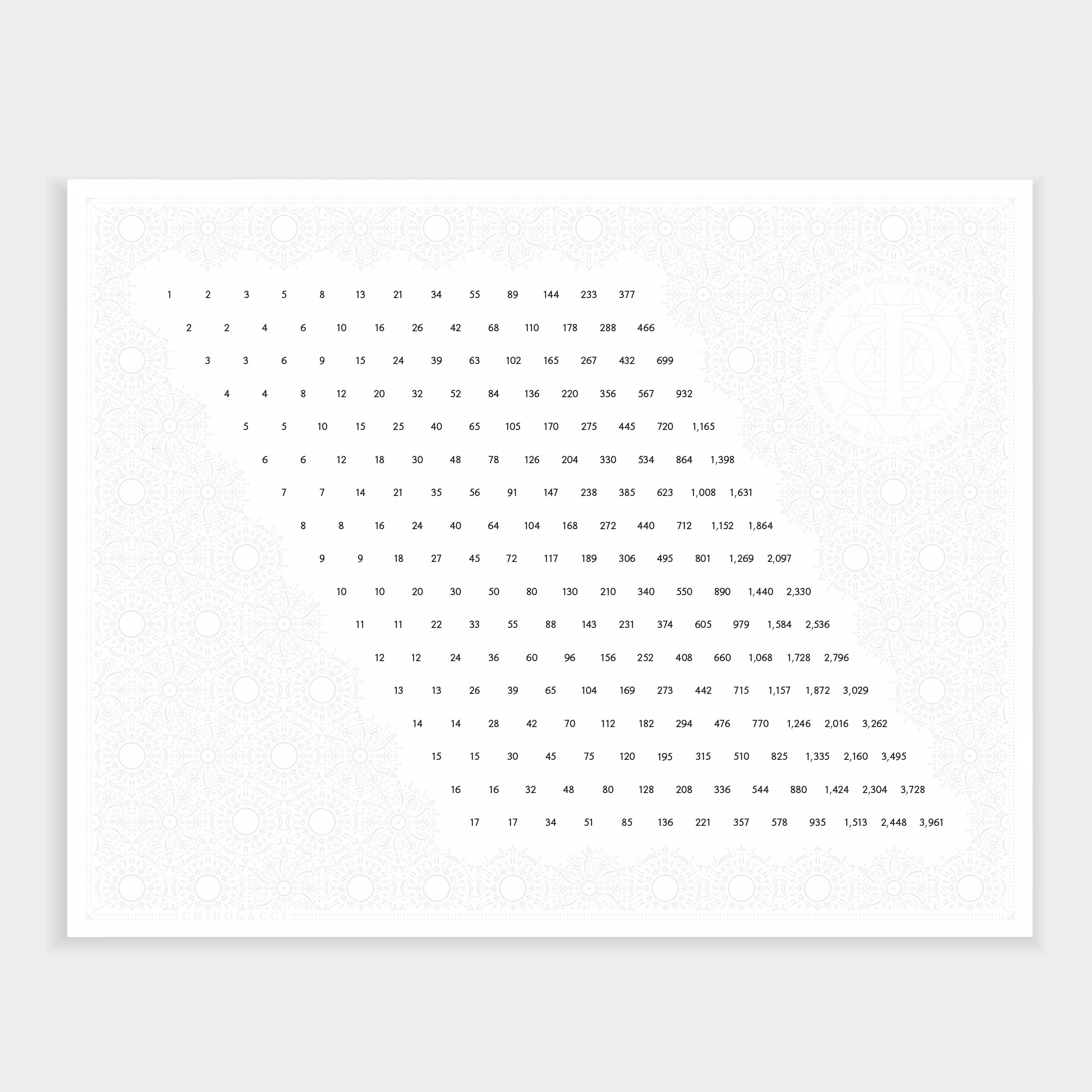
A quick reference for the Fibonacci numbers
Your Fibonacci Sequence Crib Sheet
What is it?
Cribonacci is a tool for creative professionals and students that illustrates the classic Fibonacci sequence and other number progressions that use the same formula.
Figure 1: The classic Fibonacci sequence
Starting with zero and one, each subsequent number is determined by adding the previous two numbers (0+1=1, 1+1=2, 1+2=3, etc.)
Figure 2: varying the base numbers
Starting from different base numbers yields a wider range of values.
What’s it for?
Visual harmony in design. Using Fibonacci numbers for design elements such as type size, dimensions, proportion, and spacing is pleasing to the eye. The numerical proportions in the Fibonacci sequence tend towards the golden ratio, which is found frequently in nature. For millennia, artists, designers, and architects have invoked the golden ratio as a key to intuitive visual balance. As a design tool, the Fibonacci numbers are a cheat sheet for nature’s secret law of beauty.
Figure 3: Type sizes
These type sizes were selected from the base 6 sequence (6, 6, 12, 18, 30, 48, 78, … ).
Figure 4: Proportion of visual elements
These circles, also taken from the 6 sequence, are comfortably proportioned to each other.
How do I use it?
When choosing the size of design elements, pick numbers either from a single row or from two adjacent rows:
Example 1: choosing numbers from a single row.
Example 2: choosing numbers from adjacent rows.
Note that this is not a foolproof method when combining typefaces. 12pt in one typeface might be sized very differently from 12pt in another.
Where do I get one?
You can download a free, printable 8.5" x 11" PDF here (please credit this site if sharing), or scroll down to order a beautiful and useful letterpress print for your workspace.
Free PDF – Simple
A bare-bones list of Fibonacci sequences with base numbers 1 through 17. Numbers are staggered vertically for ease when comparing adjacent rows. 8.5" x 11" PDF.
Free PDF - STIX Pattern
A list of sequences decorated with glyphs from the STIX General typeface, a free font created for the math, science, and engineering communities. 8.5" x 11" PDF.
Prints
Durable letterpress prints are the size of a standard diploma and stylish enough to display in your workplace. Check back here soon for wallet-sized cards and full-scale posters.

A note on the design
Fibonacci (Leonardo of Pisa, 1170–1240) is famous not only for the Fibonacci numbers but also for popularizing the Hindu–Arabic numerals (0 through 9) and their use in Western Europe. In 1202 he published his book Liber Abaci, which taught the Hindu–Arabic system through arithmetic problems. Until then, the merchants of medieval Europe did their accounting with Roman numerals, a far less efficient system. Imagine adding sums without the use of decimals, columns, or zeros.
He didn’t invent these numerals, nor did he discover the sequence that immortalized his name. The same sequence appears in Indian mathematics as early as 220 BC. In Liber Abaci, the sequence—which shows up in a math problem involving rabbits—is just one among hundreds of equations. Fibonacci's name was never attached to the sequence in his lifetime.
Nor did Fibonacci connect the sequence to the golden ratio. Centuries later, In 1753, another mathematician, Robert Simson, recognized the connection. In the following century, mathematician Édoard Lucas retroactively named the sequence after Liber Abaci’s author.
The history of the Fibonacci numbers illustrates a grand tradition of scholars poaching and reapplying knowledge in the name of enlightenment and progress. In this spirit, Cribonacci is offered as a free resource, designed in a free font, illustrating a free concept. The design is inspired by Hindu and Arabic art and celebrates the abstract symbols that we use to communicate math and language—all of which, it could be said, attempt to replicate and explain nature. See if you can spot the rabbits.












